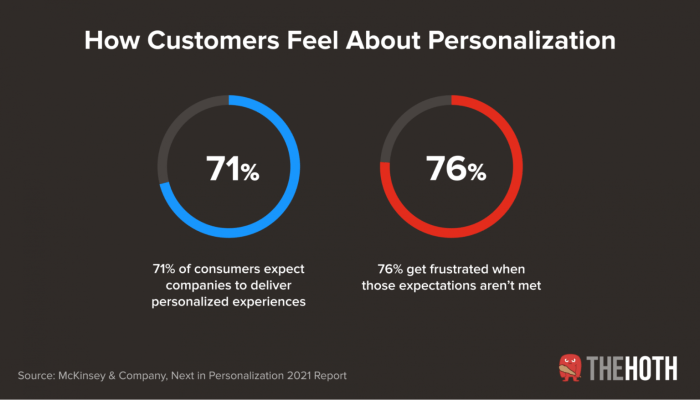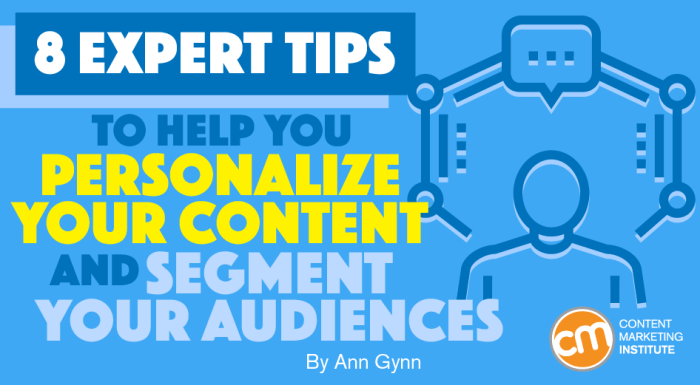When it comes to Content Personalization Tips, get ready to dive deep into enhancing user engagement with cutting-edge strategies. From data analytics to dynamic content, this topic will revolutionize the way you create personalized experiences for your audience.
Explore the innovative approaches and best practices that can take your content to the next level and leave a lasting impact on your readers.
Overview of Content Personalization
Content personalization is the customization of content based on individual preferences, behavior, and demographics. It involves tailoring the content to meet the specific needs and interests of each user, creating a more personalized and engaging experience.
Businesses benefit greatly from content personalization as it helps in improving customer satisfaction, increasing engagement, and driving conversions. By delivering relevant content to users, businesses can enhance brand loyalty, build stronger relationships with customers, and ultimately boost sales and revenue.
Examples of Industries Benefiting from Content Personalization
- Retail: Retailers use content personalization to recommend products based on past purchases, browsing history, and preferences, creating a more personalized shopping experience for customers.
- Media and Entertainment: Streaming platforms personalize content recommendations based on viewing history and preferences, keeping users engaged and increasing watch time.
- Travel: Travel companies personalize recommendations for destinations, accommodations, and activities based on user preferences and past travel behavior, creating tailored travel experiences.
- Healthcare: Healthcare providers use content personalization to deliver relevant health information, treatment options, and resources based on individual health conditions and needs, improving patient engagement and outcomes.
Strategies for Effective Content Personalization

In the world of content personalization, it’s crucial to have effective strategies in place to engage your audience and drive conversions. Let’s dive into some key tactics that can help you tailor your content for maximum impact.
Role of Data Analytics in Tailoring Content
Data analytics plays a vital role in content personalization by providing valuable insights into user behavior, preferences, and interests. By analyzing data such as website interactions, purchase history, and demographic information, you can better understand your audience and create personalized content that resonates with them.
- Utilize tools like Google Analytics to track user engagement and identify patterns in content consumption.
- Segment your audience based on their behavior and preferences to deliver targeted content that meets their specific needs.
- Monitor key metrics such as click-through rates, time spent on page, and conversion rates to measure the effectiveness of your personalized content.
Creating Buyer Personas for Personalized Content
Building detailed buyer personas is essential for crafting personalized content that speaks directly to your target audience. By defining specific characteristics, preferences, and pain points of your ideal customers, you can create content that addresses their needs and interests.
- Conduct market research and surveys to gather insights about your target audience’s demographics, behavior, and motivations.
- Create detailed buyer personas that include information such as age, gender, job title, interests, and purchasing behavior.
- Use buyer personas to tailor your content messaging, tone, and delivery channels to resonate with different segments of your audience.
AI and Machine Learning in Content Personalization
AI and machine learning technologies have revolutionized content personalization by enabling marketers to deliver hyper-targeted and relevant content at scale. These advanced technologies can analyze vast amounts of data in real-time to make personalized recommendations and predictions.
- Implement AI-powered algorithms to personalize content recommendations based on user behavior and preferences.
- Use machine learning models to predict future content engagement and optimize personalized content delivery.
- Harness the power of AI chatbots to provide personalized recommendations and assistance to users in real-time.
Implementing Dynamic Content: Content Personalization Tips

Dynamic content is all about serving up different content to different users based on their preferences, behavior, or demographics. It’s like having a personalized experience for each visitor to your site, making it more engaging and relevant. The main advantage of dynamic content is that it can significantly improve user engagement, conversion rates, and overall user experience.
Examples of Dynamic Content
- Personalized product recommendations based on past purchases or browsing history.
- Dynamic pricing based on the user’s location, time of visit, or previous interactions.
- Customized landing pages for different audience segments, such as new visitors, returning customers, or social media referrals.
A/B Testing Dynamic Content
A/B testing dynamic content involves creating multiple variations of content and showing them to different segments of your audience to see which performs better. This allows you to optimize your content for maximum engagement and conversion. By testing different headlines, images, calls-to-action, or even entire sections of your website, you can gather data on what resonates best with your audience and make data-driven decisions to improve performance.
Personalizing Email Campaigns
When it comes to email marketing, personalization is key to standing out in a crowded inbox. By tailoring your emails to individual recipients, you can increase engagement, click-through rates, and ultimately, conversions.
Segmenting Email Lists, Content Personalization Tips
Segmenting your email lists is crucial for running personalized campaigns. By dividing your subscribers based on demographics, behavior, or interests, you can send targeted content that resonates with each group. This can lead to higher open rates and better overall performance.
- Create segments based on customer behavior, such as past purchases, website visits, or email interactions.
- Use demographics like age, location, or job title to further refine your email lists.
- Consider segmenting based on interests or preferences indicated by subscribers themselves.
Crafting Personalized Subject Lines and Content
Crafting personalized subject lines and content is another crucial aspect of email personalization. These elements are the first things recipients see and can greatly impact whether they open your email or not.
- Include the recipient’s name in the subject line or email content to create a sense of familiarity.
- Use dynamic content to tailor the message based on the recipient’s past interactions or preferences.
- A/B test different subject lines and content to see what resonates best with your audience.
